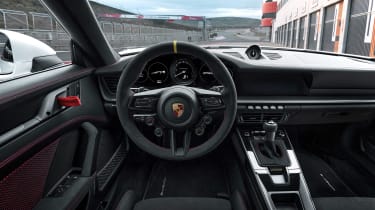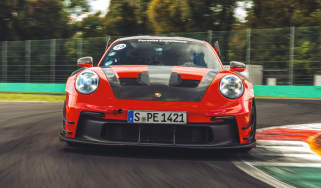2022 Porsche 911 GT3 RS completes 'Ring lap in 6:49.3
Porsche's new GT3 RS has set a blistering lap time at the 'Ring, but not a record-breaking one...
Porsche has sent its new 992 GT3 RS around the Nürburgring with Jörg Bergmiester at the wheel, unleashing its ferocious capability to the fullest. It completed a lap time of 6:49.328, not exactly a record-breaking time, but one that's extremely impressive given the RS's relatively restrained power figure. The lap was completed by completely stock GT3 RS fitted with the Weissach package and a set of Michelin Cup 2R rubber.
Of course, the new 992-generation 911 GT3 RS is the most track-focused series-production 911 yet, joining a family that traces its roots back to the iconic 1973 2.7 Carrera RS to today’s brilliant GT4 RS. In the new 911 GT3 RS, Porsche has pushed the limits of what it feels is possible for a road car.
It starts with the current 992 911 GT3 as a base, but as with RS that have gone before its wider body is shared with the Turbo and from here Porsche’s gone to new extremes, replacing the bonnet, front wings, and doors with carbonfibre reinforced plastic (CFRP) items. Changes aimed at keeping weight gain to a minimum and creating genuine downforce rather than simply reducing lift. It has resulted in the most aggressively designed aero package ever seen on a road legal 911.
> Porsche 911 Sport Classic 2022 review – official restomod for the Singer generation
As with previous generations of 911 RS models this new GT3 RS won’t technically be a limited edition, yet its build numbers will be limited by production capacity, making this yet one more RS product that requires a very healthy relationship with your local Porsche centre to secure. If you do, you might not be shocked to see a near-£50,000 price rise over the current GT3 at £178,500, yet the depth of the new RS’s chassis and aero changes are so extensive, that this price point feels like something of a bargain when a Lamborghini Hurácan STO or McLaren 765LT both cost closer to £300,000.
Engine and gearbox
Despite the extensive use of carbon, there’s so much new hardware on the RS that its kerb weight is actually slightly up on the standard GT3, weighing in at 1450kg, 15kg more than an equivalent GT3 fitted with a PDK gearbox (the only ‘box the GT3 RS is available with). To compensate Porsche has found an additional 14bhp for its 4-litre flat-six, which now produces 517bhp, derived largely from a new cam profile, a new single-throttle intake system and rigid valve drive borrowed from Porsche’s race cars. The seven-speed PDK is fitted with a shorter final drive and new ducting to assist cooling on-track.
These mechanical changes help it reach 62mph in 3.2sec, 0.2sec faster than a standard GT3 PDK. A compromise of the aggressive aerodynamic package is the reduced top speed, which despite a drag reduction system (DRS), is down 14mph to 184mph.
Aerodynamics
The most obvious new aero device is the GT3 RS’s rear wing, which is not only larger but also mounted higher on its reshaped swan-neck mounts (so high, in fact, it’s above the roofline). Its construction is of a two-piece design, the top element being hydraulically adjustable to facilitate a new DRS system. The wing is balanced by a front splitter that actively splits the airflow above and below the car, directing the air to either the rear wing or rear diffuser depending on speed and the requirements of the rear wing.
While the front end’s design might look ostensibly similar to the standard GT3, aerodynamically the two cars’ front aero work in completely different ways. That’s because the RS features a single, large, centrally-mounted radiator, instead of a standard GT3’s two smaller units that sit ahead of the front wheels. It’s vented through two huge openings in the CFRP bonnet, which dissipates so much heat that Porsche has fitted two small fins on the roof to help direct the hot air outwards, rather than letting it attach itself to the high-speed cooler airflow that feeds the RS’s main engine intake at the base of the rear glass. The side intakes aren’t used to feed the engine intake, rather they assist aero around the rear end.
Porsche has also fitted various aero devices around both front and rear wheel arches. As with the 991, the front arches are ventilated at the top to relieve air pressure, but this is now aided by huge outlets inspired by those used on the 911 GT1 Le Mans racer of the late Nineties. To manage the merging of airflow from inside and outside of all the wheel arches, Porsche’s fitted side-blades on both axles, and in the case of the front arches, integrated a hidden LED turn signal into the upright section’s supporting beam.
The result of all these devices are some quite incredible numbers. The GT3 will produce a maximum downforce of 860kg at 177mph, and 409kg at 124mph, double that of a 991.2 GT3 RS, and three times more than a contemporary 992 GT3.
Chassis
Alongside the aero elements Porsche has gone to town on the chassis and its adjustability. As with the current GT3 the basic suspension layout combines a double-wishbone front and multi-link rear setup, with coil springs on adjustable dampers. Only this time, the damper adjustment is no longer restricted to just three broad settings. For the first time in any Porsche, the suspension can be adjusted for both compression and rebound to eight different settings on each specific axle, on the move. It’s a level of adjustability that’s not unusual in high-end track cars, but comes with the ability to do it electronically, rather than with a set of tools while the car is on a jack.
These chassis settings are controlled via a new steering wheel that incorporates three additional rotary controls alongside the drive mode selector switch. When the PASM rotary dial is activated a second rotary control allows you to adjust the compression and rebound independently with each setting displayed with the instrument cluster’s track mode display. These three new dials, in normal circumstances, also give you access to the RS’s traction control and rear differential, the latter a newly adjustable variation of Porsche’s electronically-controlled torque-vectoring limited-slip rear diff, or PTV+. The steering wheel also activates the DRS system, with a small button placed in the usual control cluster on the right-hand steering wheel spoke.
Free of hardware ahead of the front wheels, the 29mm-wider front axle is in more direct contact with the airflow, so Porsche has designed the front wishbone arms with a tear-drop profile, producing around 40kg of downforce at maximum speed. To further assist aerodynamic balance between the axles when braking from high speeds, the ball-joint of the lower trailing arms are positioned further down on the front axle, with the rear axle picking up its own new geometry in tandem with the rear-wheel steering system.
Steel brakes are standard, featuring a new 408mm front disc with six-piston front calipers, and the existing 380mm four-piston combo at the rear. Both the piston and brake disc widths have grown ever so slightly by 2mm in both cases. Porsche’s PCCB ceramics are optional, with 410mm front and 390mm rear discs paired to six and four-piston calipers.
The RS runs on a wider wheel and tyre package than the standard GT3, too, pairing a new design of centre-lock forged wheel with 275-section front and massive 335-section rear tyres. Porsche has not confirmed the available tyre options yet, but the tyres fitted to cars in the released images are Michelin Pilot Sport Cup 2s. Some prototypes have been spotted on an as-yet unspecified Pirelli P Zero with the Trofeo RS stamping on their sidewalls – these could take over from a Cup 2R.
Clubsport and Weissach packages
There will be both Clubsport and Weissach packages available for the RS, the former coming at no extra cost, incorporating a steel roll-over bar, harnesses for the standard fit carbon-backed bucket seats and a fire extinguisher. The Weissach package takes things further, incorporating bespoke carbonfibre front and rear anti-roll bars, a carbonfibre shear panel on the rear axle and a brand new CFRP rollover hoop that saves 6kg over the Clubsport’s steel unit.
This is combined with an exposed carbonfibre weave finish to the bonnet, roof, certain elements of the rear wing and upper-half of the side mirror shells, plus a bespoke mechanism for the steering wheel-mounted shift paddles. The Weissach package without the CFRP roll hoop costs £22,515, or £25,739 with. Beyond this, there’s also a further set of optional magnesium wheels only available in combination with the Weissach pack.
The GT3 RS is available to order now from £178,500, with Porsche yet to confirm precise dates for the first customer deliveries.
2022 Porsche 911 GT3 RS (992) specs
| Engine | Flat-six, 4-litre |
| Power | 517bhp |
| Weight | 1450kg |
| Power-to-weight | 357bhp/ton |
| 0-62mph | 3.2sec |
| Top speed | 184mph |
| Downforce | 860kg (177mph) |
| Price | £178,500 |











